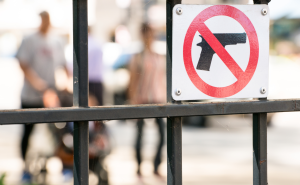CDC Provisional Data: Gun Suicides Reach All-time High in 2022, Gun Homicides Down Slightly from 2021
In 2022, the gun suicide rate among Black teens surpassed the rate among white teens for the first time on record.

The CDC released updated provisional gun death data for 2023. While there are some signs of improvement, troubling trends persist, particularly among vulnerable demographic groups. Read our key takeaways from the CDC's 2023 provisional gun death data.
Newly released provisional data from the Centers for Disease Control and Prevention shows that gun death rates in 2022 remained near highs not seen since the mid-90s and, in addition, rates have not returned to pre-pandemic levels.
Guns remained the leading cause of death for children and teens in 2022. The rate of gun deaths among this group climbed 87% in the last decade (2013-2022). The data also showed gun violence continuing to have a disproportionate impact on Black children and teens, who have a gun homicide rate 20 times higher than their white counterparts. Additionally, the nation’s overall gun suicide rate increased 1.6%, reaching an all-time high, and for the first time, the gun suicide rate among Black teens surpassed the rate among white teens.
The analysis of the new data was conducted by researchers at the Johns Hopkins Center for Gun Violence Solutions. The CDC makes provisional data available each year ahead of final numbers. Historically, the changes between provisional numbers, which are released in the summer, and final numbers, which are released in the winter, are minor.
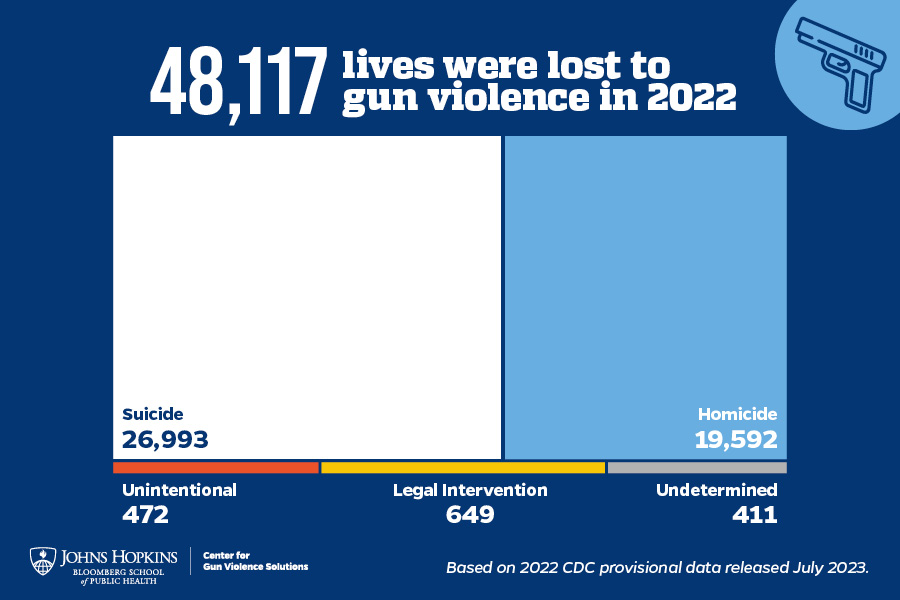
Overall gun death rate decreases, number of gun suicides reaches all-time high
According to the provisional CDC data, 48,117 people died by guns in 2022, an average of one person every 11 minutes. The overall gun death rate declined 1.9% in 2022 from 2021. While this overall decrease in the gun death rate was small in relative terms, 713 fewer people died by guns in 2022 compared to 2021. This provisional data illustrates that the 2020 spike in gun violence seen during the COVID-19 pandemic has not returned to pre-pandemic levels. Overall, including this new provisional data for 2022, gun deaths are up 21% since 2019.
The gun homicide rate decreased 6.8% in 2022, with 1,366 fewer gun homicides in 2021. Even with this decrease, 19,592 people were killed by a gun in 2022, the second-highest gun homicide rate since 1995. Although the surge in gun homicides appears to have leveled off, the 2022 gun homicide rate is still 35% higher than it was in 2019. If the gun homicide rate had remained at 2019 levels, approximately 5,000 fewer people would have been killed in 2022.
Gun suicides continued to reach all-time highs, increasing 1.6% from a previous record in 2021; 26,993 people died by gun suicide in 2022. While the increase in gun homicides has gained public awareness, less attention has been paid to the growing epidemic of gun suicides – which historically make up the majority of gun deaths. The gun suicide rate has steadily increased, nearly uninterrupted, since 2006. In 2021 it reached the highest levels since the CDC began recording such data in 1968; and this past year, in 2022, it surpassed that record.
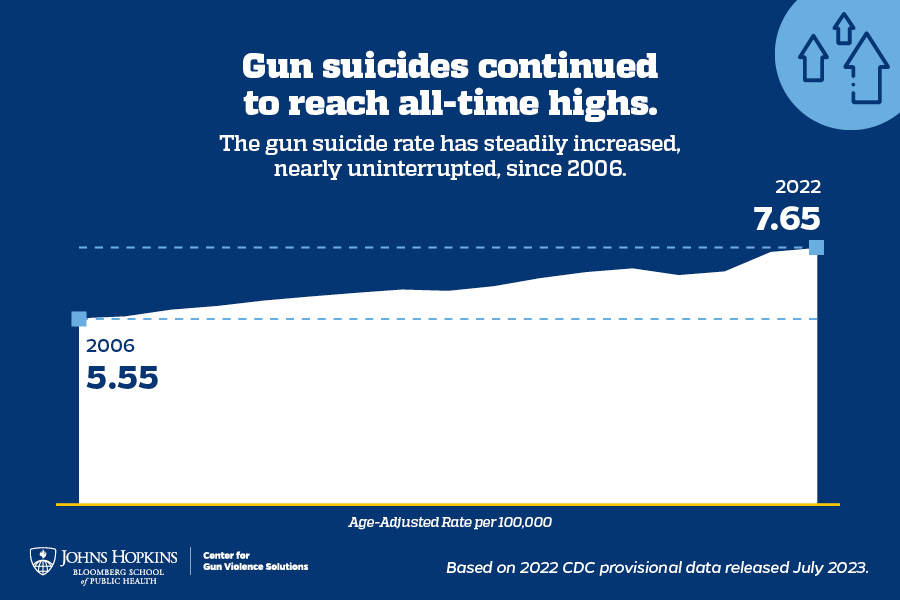
Guns remain the leading cause of death for children and teens
Guns were the leading cause of death for children and teens (ages 1-19) in this country for the fifth straight year. The rate of gun deaths in this group fell slightly, by 3% from 2021, a total of 4,590 deaths in 2022. It remains near record highs – 2022's gun death rate for children and teens was the second highest rate in 25 years behind 2021. In the past decade (2013-2022), the gun death rate among children and teens has increased 87%. Both gun homicides and suicides fueled this increase.
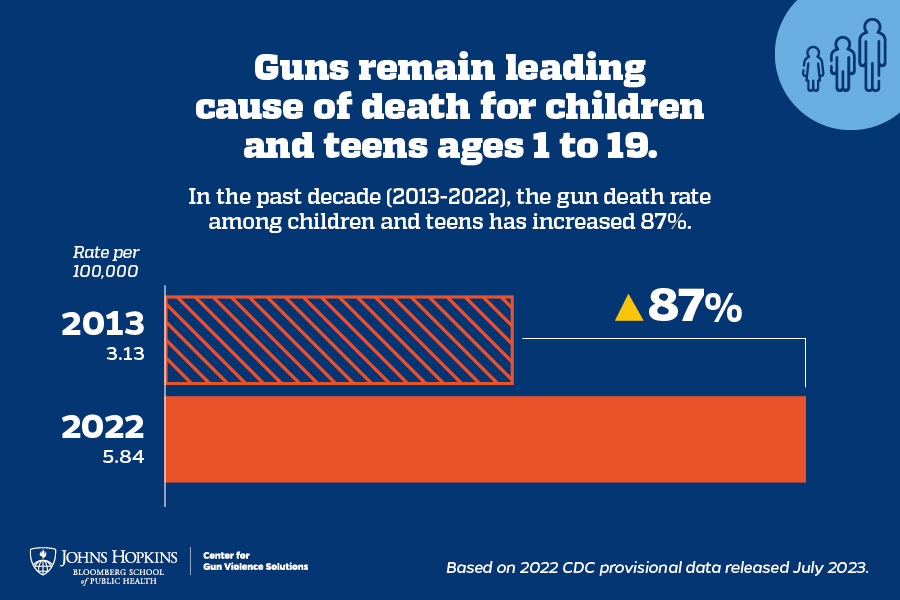
Guns continue to disproportionately impact Black children and teens
In 2022, Black children and teens were 20 times as likely to die by firearm homicide compared to their white counterparts.
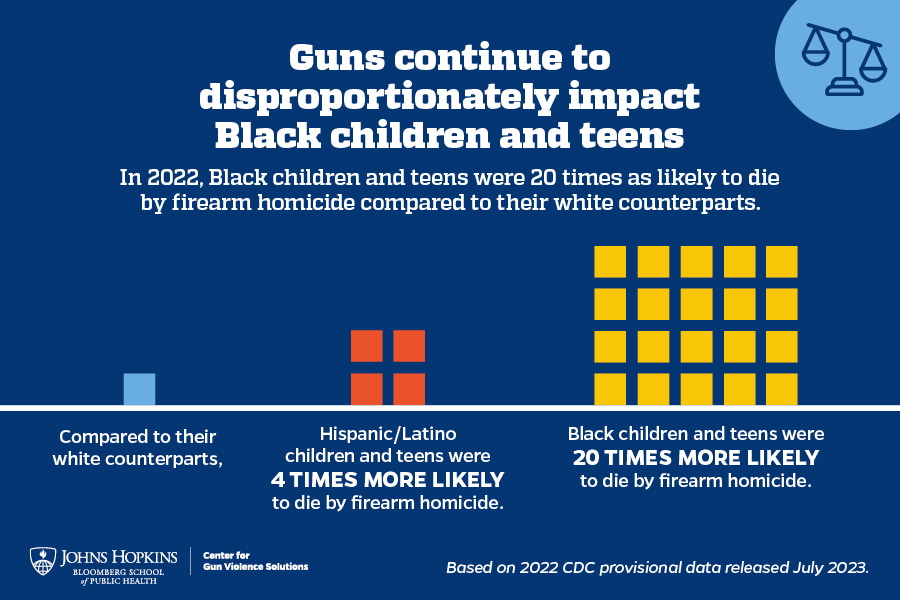
In 2022, the gun suicide rate among Black children and teens (age 10-19) surpassed the rate among white children and teens (age 10-19) for the first time on record. Historically, white children and teens have had higher gun suicide rates than their Black counterparts. The Black child and teen suicide rate tripled over the past two decades (2003-2022).
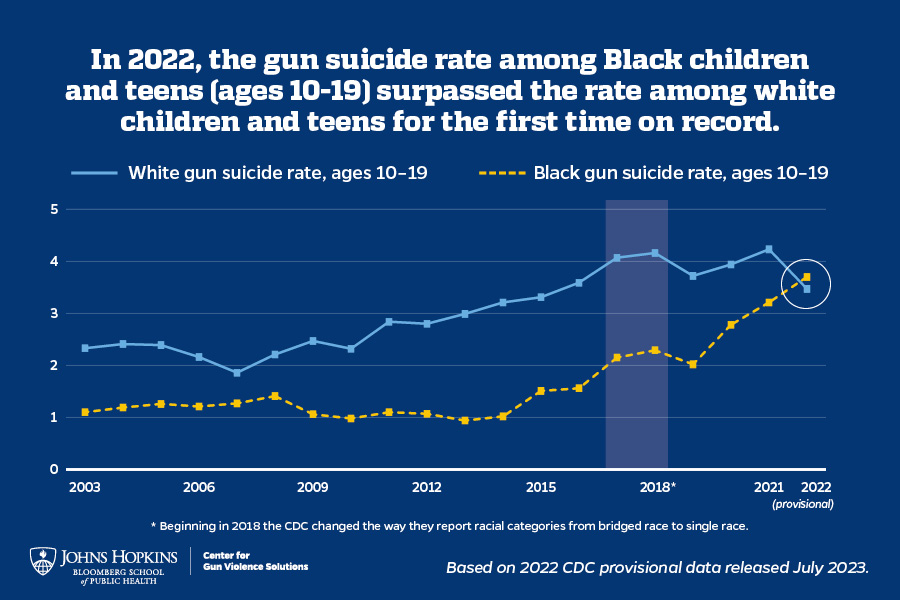
Evidence-based solutions to reduce the violence
“The provisional data shows that the American epidemic of gun violence persists,” said Ari Davis, policy advisor at the Johns Hopkins Center for Gun Violence Solutions. “Guns remain the leading cause of death for children and teens ages 1-19; gun homicides continue to drive deep health inequities by race and ethnicity; and gun suicides continue to take the lives of elderly white men at high rates and increasingly, the lives of Black teens. We are all impacted by this ongoing public health crisis. It is past time for our leaders to enact evidence-based solutions to address it.”
The Center has identified evidence-based policies demonstrated to help reduce gun violence including:
Implementing permit-to-purchase laws, also known as gun purchaser licensing.
Using Domestic Violence Protection Orders and Extreme Risk Protection Orders—sometimes called “red flag” laws—to temporarily remove firearms from individuals determined to be at elevated risk for violence.
Investing in community violence intervention programs.
Adopting child access prevention laws mandating safe firearm storage in households with children and/or teens.
Enacting stronger concealed carry permitting laws, and repealing “stand-your-ground” laws.
About the data
All provisional data is part of the CDC WONDER database, which is based on death certificates. The CDC is expected to release its finalized 2022 gun violence data this winter. There may be small differences between provisional and final data. In past years, changes have been minor. The Johns Hopkins Center for Gun Violence Solutions releases an annual report analyzing the final CDC gun death data. The most recent report, U.S. Gun Violence in 2021: An Accounting of a Public Health Crisis, was released in June 2023.



